WORLD NO : 1 STUDY ABROAD DESTINATION
Wish to Study in USA
"Get free 60-Minutes Counseling"
@ TEC
Discover all you need to know about studying in USA.
Book a counseling session now!
Connect with a USA Counselor Today
Fill out this form for booking a consultant advising session.
Wish to
Study IN USA
but not sure
where to begin?
Book a Free "60-min Counseling" from our Expert USA Counsellor
Discover all you need to know about studying in USA.
Book a counseling session now!
Connect with a USA Counselor Today
Fill out this form for booking a consultant advising session.

A Comprehensive guide into Study in USA
Why Choose to
Study in USA
Details on Studying Abroad | Qualifications Needed | Financial Breakdown | Available Courses and Opportunities | Job Prospects
Study in USA
Studying in the USA transcends the mere acquisition of a degree; it's an engagement in a vibrant environment that fosters personal development, innovation, and a broad international outlook. With over 1.1 million international students, the United States stands as the premier destination for education globally. It is home to 16 of the top 50 universities worldwide, as per the 2023 QS World Rankings. The nation offers a rich tapestry of cultures, top-notch educational standards, a distinctive curriculum, and a hotbed for innovation, entrepreneurship, and opportunities post-graduation, which are key draws for students worldwide.
Beyond its appeal as a prime tourist spot, the USA is celebrated for its diverse culture and is the preferred choice for international students. It is particularly renowned for its STEM courses, cutting-edge research, and extensive job opportunities available to students both during and after their studies. In 2022, there were 211,930 Indian students in the US, highlighting its popularity among this demographic. Continue reading for detailed insights on sought-after courses, leading universities, intake sessions for 2023, visa prerequisites, and the top cities for students in the USA.
Key Points on Studying in the USA: Ranked third globally for attracting international students, the USA saw a 19% increase in Indian student enrollments in 2021-22, even outpacing China in the 2022-23 period. During June to August alone, 82,000 US visas were granted to Indian students, the most for any country, underscoring the country's appeal for academic pursuits.
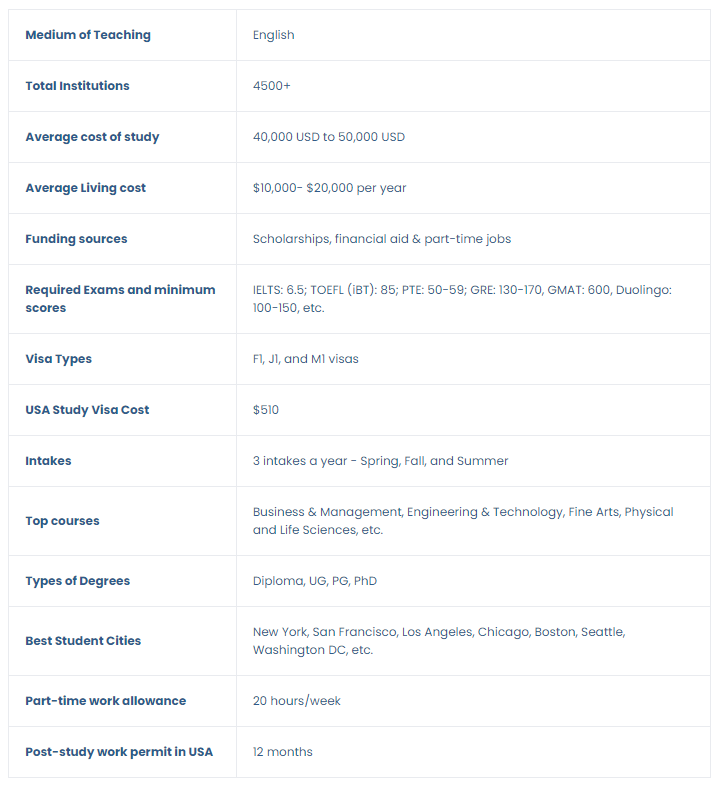
US Education System
The U.S. education landscape is diverse, with institutions categorized into four types: state colleges or universities, private colleges, community colleges, and technical institutes. In the U.S., approximately 4,500 accredited institutions offer three primary degree levels. Like in India, after completing high school, students in the U.S. pursue higher education at either public or private institutions.
Post-high school, the typical undergraduate (Bachelor’s) degree spans four years. At community colleges, an associate degree, akin to a diploma, requires two years of study. For a graduate or Master’s degree at a U.S. university, students invest 2-3 years, while a Ph.D. or doctoral program can take between 5 to 8 years to complete.
Why Study in the USA? Six Key Advantages
Many international students ponder the value of U.S. education. Let’s explore the key benefits that make the U.S. an attractive study destination:
Educational Flexibility: The U.S. higher education system offers immense flexibility in program structure and course selection, enhanced by a credit transfer system and the option for online or in-person classes at convenient times.
World-Class Institutions: The U.S. boasts some of the globe’s most prestigious universities, with degrees that are internationally recognized. Institutions like MIT, Stanford, Harvard, and Caltech consistently top global rankings.
Vibrant Student Life: U.S. educational institutions offer a rich student life that includes a variety of extracurricular activities and opportunities for social engagement.
STEM Opportunities: U.S. universities provide an extensive array of STEM programs, granting international students an additional two years of stay after their degree completion. The U.S. also values arts and humanities highly.
Research and Innovation: With cutting-edge technology and modern educational resources, the U.S. offers abundant research and training opportunities for international students.
Employment Prospects: Approximately 62% of graduates find employment in the U.S. upon completing their degrees, showcasing the country’s strong job market for graduates.
Best Places to Study in USA
The United States, encompassing 50 states, is home to globally renowned universities across a variety of vibrant cities, each offering unique educational and professional opportunities. While selecting a university is crucial, understanding the top student cities in the USA can also significantly enhance your study experience. Here's a brief overview:
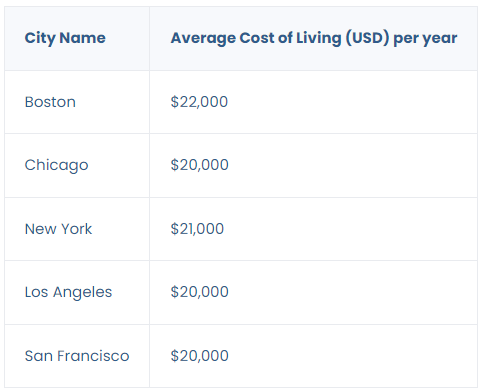
How to Study in USA?
Embarking on your educational journey in the USA, whether for a short course or a full degree program, involves a comprehensive 6-step process:
-
Explore Your Options: Begin by thoroughly researching potential study opportunities in the USA, including top universities and courses. Investigate financial aid and scholarship options provided by universities to support your education.
-
Financial Planning: Understand the financial requirements of studying in the USA. Costs can vary, with undergraduate programs ranging from $15,000 to $55,000 USD annually, and postgraduate programs costing between $15,000 and $30,000 USD per year.
-
Application Preparation: Start your application early, focusing on creating a strong profile that includes a statement of purpose, letters of recommendation, a personal essay, and preparing for any interviews.
-
Standardized Tests: Take necessary standardized tests such as the IELTS, TOEFL, PTE for English proficiency, and the GRE, GMAT, SAT, or ACT, depending on your chosen program's requirements.
-
Visa Application: After securing an admission offer and receiving the I-20 form, proceed to apply for a student visa at the nearest U.S. embassy or consulate.
-
Departure Preparations: Once your visa is approved, notify your university, gather necessary immigration and pre-departure documents, pack your belongings, and get ready for your new academic adventure in the USA.
Intakes to Study in USA
Understanding the various intake periods in the USA is crucial for planning your overseas education. In the U.S., the academic terms are often referred to as "semesters." Unlike Indian institutions, American colleges and universities typically offer three main admission cycles:
-
Fall Intake: Commencing in September, this intake is favored by many Indian students. It offers a broader range of courses and scholarship opportunities compared to other periods.
-
Spring Intake: Begins in January and is an alternative for students who may have missed the fall intake.
-
Summer Intake: Starts around May and tends to have fewer available programs and courses, as it is not as common as the fall and spring intakes.
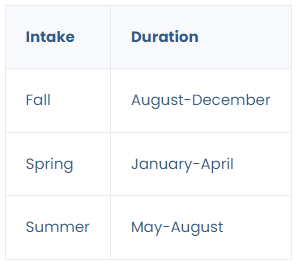
Popular Courses to Study in USA
The USA is celebrated for its prestigious educational institutions, offering top-tier programs that provide deep and engaging learning experiences. Below is a curated list of the most sought-after courses for international students in the USA, featuring a strong emphasis on STEM disciplines alongside other notable fields:
- Business and Management
- Engineering and Technology
- Marine Biology and Life Sciences
- Mathematics and Computer Science
- Medicine
- Liberal Arts
- Law
- Data Science & Analytics
For those interested in groundbreaking research and innovation in areas like neuroscience and climate change, top-tier institutions for bachelor’s programs include MIT, Yale, UCLA, Georgia Institute of Technology, University of Colorado Denver, and Washington State University.
Tuition fees for these popular programs in the USA typically range between USD 40,000 and USD 50,000 per annum.
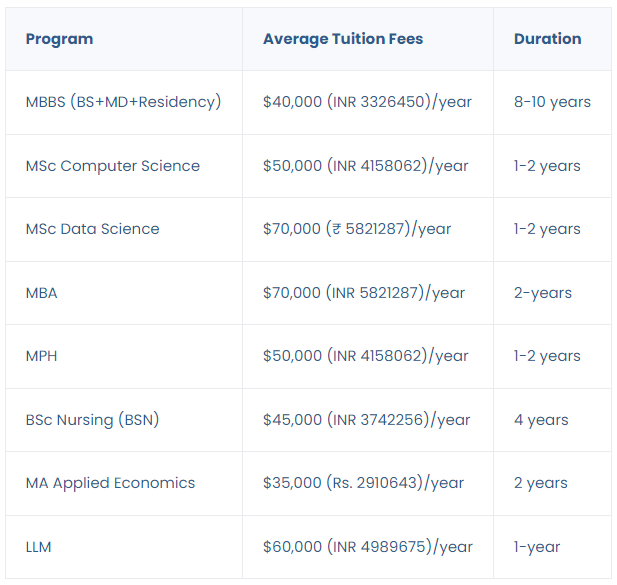
Top Universities to Study in USA
Leading universities in the USA are renowned for their exceptional teaching quality and educational frameworks, playing a crucial role in fostering the comprehensive growth of their students. Below is a list of esteemed universities in the USA where you can pursue your studies:
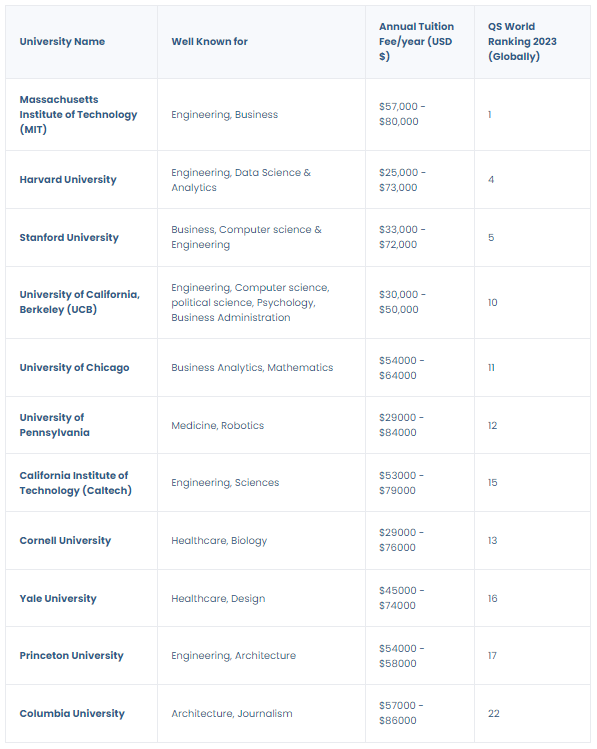
Admission Requirements to Study in USA Universities
To realize their aspirations of studying in American universities, international students must satisfy the following standard entry requirements:
- Academic Transcripts: Essential for assessing your previous educational background.
- Work Experience Letters: If applicable, to demonstrate professional expertise.
- Standardized Test Scores: Including GRE/GMAT for graduate programs, and SAT/ACT for undergraduate programs.
- English Language Proficiency: Validated by tests like TOEFL, iTEP, IELTS, PTE Academic, or Duolingo.
- Statement of Purpose (SOP): Articulating your academic interests and professional goals.
- Letters of Recommendation (LOR): Typically required from academic or professional references.
- Curriculum Vitae (CV): Detailing your academic and professional achievements.
- Essay: Some programs may require a personal essay as part of the application process.
- Passport Copy: A valid passport is necessary for identification purposes.
- Proof of Financial Resources: Demonstrating your ability to cover tuition and living expenses.
The minimum scores for standardized and English language tests vary depending on the university and program. Academic transcripts are evaluated and converted to the U.S. grading system, often through services like WES (World Education Services). Understanding the conversion from CGPA to the U.S. GPA system can also aid students in assessing their eligibility, particularly with the American 4-point grading scale.
For those interested in specific degree requirements, additional details can be provided to tailor your preparation accordingly
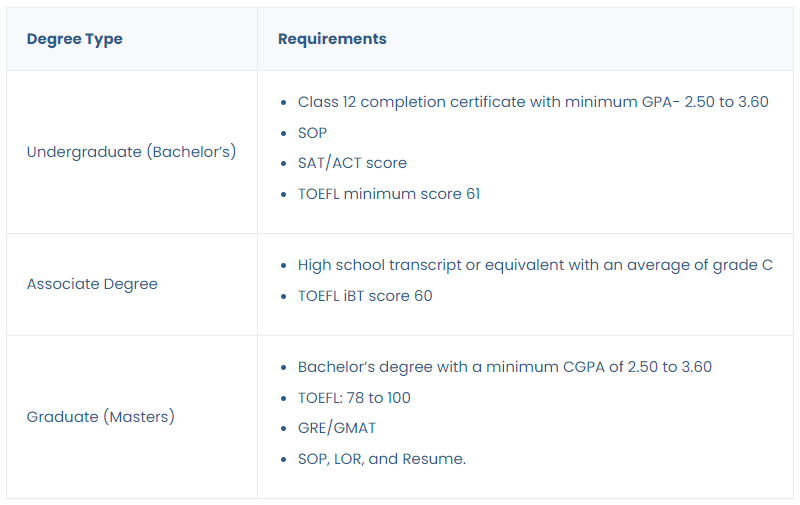
USA Student Visa Requirements for International Students
For international students aiming to study in the USA, understanding the student visa requirements is crucial. Here's a comprehensive guide on the types of student visas offered by the U.S. government, their eligibility criteria, and the application process:
The United States offers three primary types of student visas: 1) F-1 Student Visa, 2) J-1 Exchange Visitor Visa, and 3) M-1 Student Visa, with the F-1 being the most commonly sought. For detailed information, it's recommended to visit the U.S. Department of State's website. Below is a step-by-step process to follow when applying for a U.S. student visa:
- Gain admission to a school or program approved by the Student and Exchange Visitor Program (SEVP) in the USA, ideally 6 to 12 months before your program starts.
- Once admitted, you'll receive an I-20 or DS-2019 form from the institution, which is essential for the visa application process.
- Pay the SEVIS (Student and Exchange Visitor Information System) fee at least three days prior to submitting your visa application. This can be done online or via a paper form, with more details available on the ICE SEVP website.
- Schedule an appointment at your local U.S. consulate or embassy for your student visa application.
- Pay the Machine Readable Visa (MRV) fee as required.
- Attend the visa interview, bringing all necessary documents as specified on the embassy's website. Check in advance what you need to bring.
- Fill out the DS-160 Visa application form online, selecting where you will apply and ensuring you have all necessary documents.
Tips for the process: Arrive at your visa interview at least 30 minutes early.
For further assistance and to expedite the visa process, consider utilizing the services of the Offsite Facilitation Center (OFC) provided by the U.S. embassy.
Documents typically required for the U.S. student visa application include:
- Your full name and date of birth.
- Contact information, including a mobile number with the country code and your address.
- Passport details.
- Information about your travel plans, any previous visits to the U.S., and a contact person in the U.S.
- Your educational background, employment history, and family information.
- Scores from English language proficiency tests.
- Medical and health information.
- Proof of financial stability in your home country.
- Your SEVIS ID and the address of the U.S. institution you will attend, as found on the I-20 or DS-2019 form.
When to apply for a US Student Visa?
The F-1 student visa is a common choice for Indian students heading to the USA. Applicants can initiate the student visa process up to 365 days prior to their course's commencement. However, they are allowed to enter the USA no more than 30 days before their classes begin.
What is the cost to apply for US Student Visa?
The application fee for an F-1 student visa is USD $510, equivalent to approximately INR 42,203. It's advisable to apply well in advance to ensure there's sufficient time for the processing of your application. This early start also provides you with ample time to gather any additional documents needed for your visa and university applications.
Scholarships to Study in USA Universities
Scholarships are typically awarded to candidates following interviews with admissions representatives. International students looking to study in the USA have access to a variety of scholarships, including those funded by government bodies, non-governmental organizations, and specific universities. These scholarships are often awarded based on academic merit or outstanding performance in extracurricular activities. For Indian students aiming to minimize their educational expenses in the USA, it's crucial to be aware of and apply for the top scholarships available. Here's what you need to know:
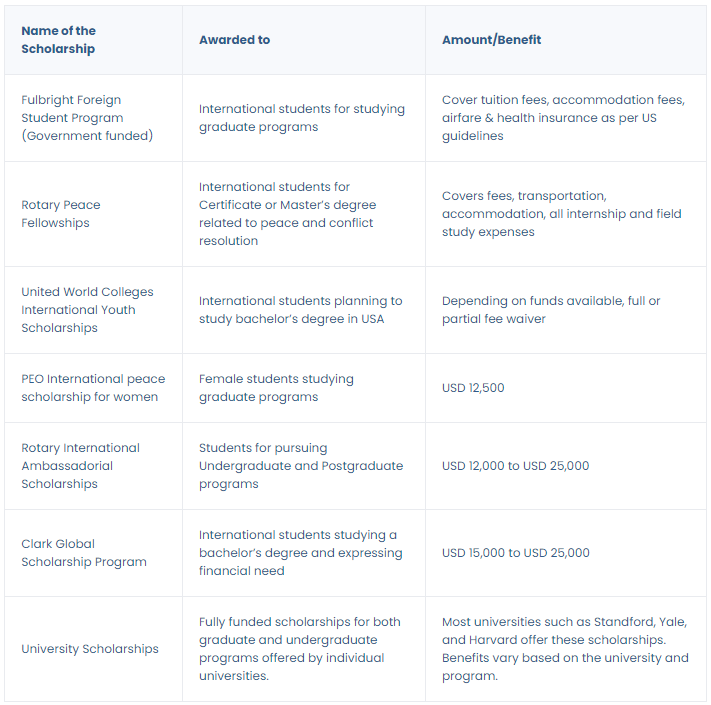
Education Loan for Studying in Canada
The cost of studying in Canada can vary based on your program, university, course length, and living expenses. For students needing financial support, numerous banks and financial institutions offer education loans specifically for studying in Canada. It's crucial to check the eligibility criteria before applying to ensure you qualify for a loan. Since loans can differ in what they cover, it's wise to talk to your bank to get the lowdown on what expenses are included. Typically, education loans can help with costs like:
-
Enrollment and tuition fees
-
Travel expenses
-
Course materials like books and stationery
-
Lab fees
-
Accommodation and meal costs in a hostel
-
Buying a laptop if it's needed for your studies
-
Funding for any project work or educational trips
Cost of Studying in Canada
The annual tuition fees in Canada vary, ranging from CAD 13,000 to CAD 35,000, depending on the program and institution. Typically, courses in humanities, education, and arts are less costly, whereas medicine and engineering come with higher price tags. On average, an undergraduate program might cost about CAD 6,800 (which is roughly Rs. 4,16,582) per year, while a master's degree could set you back about CAD 21,100 each year, according to 2022 data from Statistics Canada.
For postgraduate courses, especially MBAs, expect tuition fees to fall between CAD 30,000 and CAD 42,000. When you stack it up against other developed nations, Canada is relatively affordable, offering a range of financial aid options like scholarships, loans, bursaries, and assistantships for international students.
For a clearer picture, refer to the table below that outlines the estimated tuition fees based on the program level.
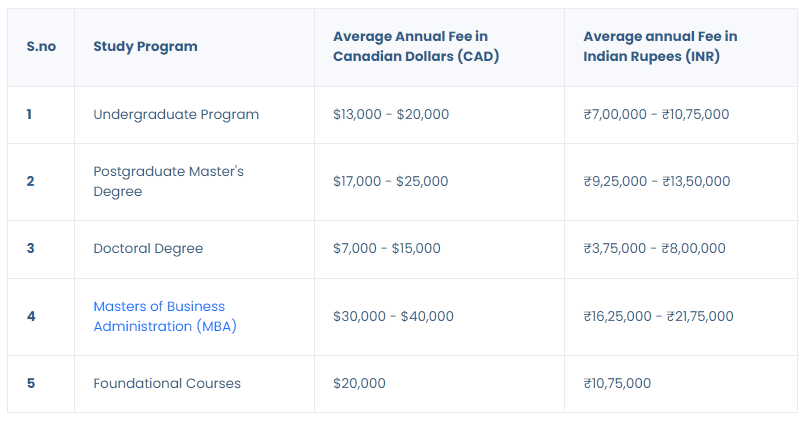
Cost of Living in Canada
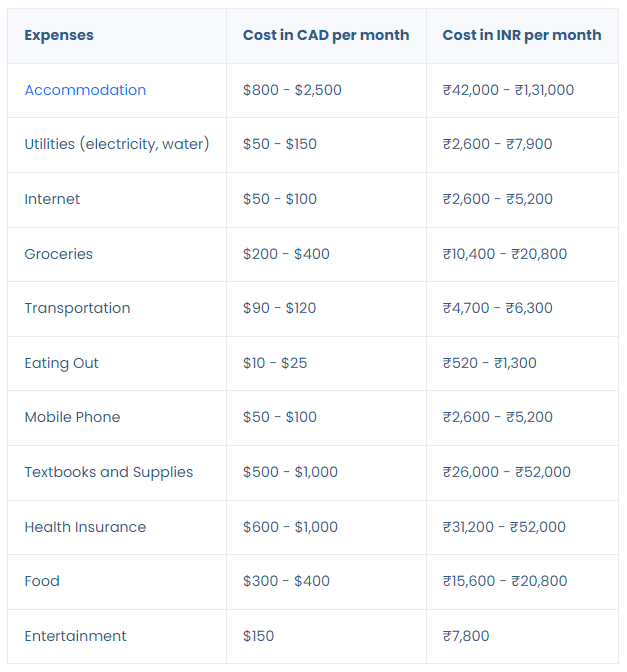
Part-time Job Options in USA
While studying in the USA, students have the opportunity to engage in part-time employment, with options for working either on-campus or off-campus. On-campus employment allows students to work within their college or university's premises, while off-campus employment is typically related to their field of study.
For off-campus work, students can explore four main categories: Optional Practical Training (OPT), Curricular Practical Training (CPT), jobs due to economic hardship, and positions with international organizations.
Students are permitted to work up to 20 hours per week during the academic term and full-time during breaks or upon completing their studies. The federal minimum wage in the USA is $7.25 per hour, but this can vary as each state has the authority to set its own minimum wage, with figures ranging between $7.25 to $15 per hour.
Here's a list of some common part-time jobs in the USA along with their average hourly wages:
- Barista - $11.59 per hour (approximately Rs. 961)
- Campus Ambassador - $10.94 per hour (approximately Rs. 907)
- Receptionist - $13.31 per hour (approximately Rs. 1,105)
- Sales Assistant - $20 per hour (approximately Rs. 1,660)
- Department Assistant - $16.44 per hour (approximately Rs. 1,365)
- Food Runner - $12 per hour (approximately Rs. 990)
Post-Study Work Opportunities in USA
Upon completing your education, you may explore employment opportunities to achieve a favorable Return on Investment (ROI). International students holding F-1 visas are typically permitted to work in the USA post-graduation, adhering to the guidelines and restrictions set by USCIS. Salaries for graduates can range widely, from approximately USD 53,000 to USD 157,000 annually.
The U.S. job market experiences skill shortages in various sectors, creating strong demand for graduates, particularly in fields like healthcare, real estate, film production, retail, agriculture, engineering, and IT. According to the Bureau of Labor Statistics, the U.S. is expected to add 8.3 million new jobs from 2021 to 2031, with about 23.1% (1.9 million) of these new opportunities projected in the leisure and hospitality sector.
Below is an overview of potential career paths for graduates from U.S. universities, along with the anticipated salary ranges:
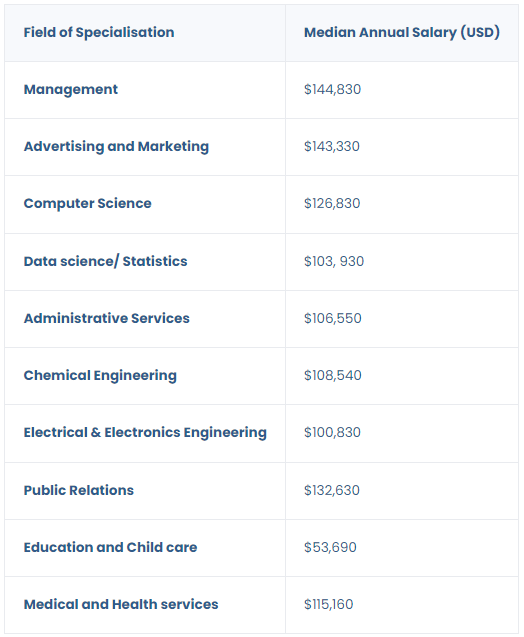
In conclusion, like any other country, the USA has its own set of advantages and challenges. However, pursuing education and gaining global exposure at esteemed American universities can have a profound impact on your personal and professional growth, steering you towards sustained success. If you're contemplating studying abroad, the United States offers a wealth of opportunities for higher education. Hopefully, this information provides a comprehensive overview of what you need to know to study in the USA. Why delay? Take the next step to make your American education dream a reality! For personalized guidance throughout your journey, TEC is here to assist you. We're just a phone call away.


Get a Free 60-Min Counselling Session
Explore options for destinations, courses, and college choices with expert guidance!
Additional Assistance - Education Loan | Travel Insurance | Air Ticketing | Visitor Visa

Thanks to the expert IELTS training, I achieved my dream score! The personalized attention and detailed resources made all the difference. Truly grateful!
Dhrupal
Broadcasting Performance & Digital Media Course, Canada.

As a non-native English speaker, I was nervous about IELTS. This program's patient guidance and strategic approach helped me succeed beyond expectations.
Dhwani Solanki
6.5 + Band Score in IELTS is First Attempt Algonquin college, Canada.

Their teaching method is exceptional! I improved dramatically in just a few months. Thank you for turning my study abroad dreams into reality!
Freya Joshi
Early Childhood Education, Georgian College

"The quality of IELTS training here is unmatched. The instructors' expertise and supportive environment were key to my high score. Highly recommend!"
Devanshu
Cleared IELTS in 1st Attempt,Yorkville University, Ontario Canada

The English Channel is the best I have ever seen. This premises has been helping students who want to pursue their dream of studying in any other nation. Teachers have totally different ways of teaching, which is a practical way to get the desired band score.
Sneh Prajapati
Studying in Canada

TESTIMONIALS
Happy Cases, Happy Faces!
With over 8 years of IELTS training experience and 750+ students helped, we're dedicated to realizing your academic and professional dreams.
Frequently Asked Questions on
Study in USA
For the current academic year, the acceptance percentages for leading U.S. universities are listed below:
- Harvard University: 4.7%
- Stanford University: 3.75%
- Princeton University: 5.5%
- Columbia University: 5.4%
- California Institute of Technology (CalTech): 6.4%
- University of Chicago: 7.3%
- Massachusetts Institute of Technology (MIT): 6.7%
In the United States, universities utilize a uniform credit system where the credits a student accumulates are crucial for determining their final result.
For an undergraduate degree, students typically need 3-5 credits per class hour, amounting to a total of 120-130 credit hours to graduate.
For a Master's degree, each course generally requires 3-4 credits, with a total of 30-64 credit hours needed for completion.
The American education system employs the GPA (Grade Point Average) scale, which ranges from 0.0 to 4.0. Semester grades are calculated based on the marks received in each course and the associated credits. On this scale, a 4.0 GPA corresponds to an A grade, whereas a 0.0 signifies an F grade.
Initially, submit an application to an institution endorsed by the Student and Exchange Visitor Program (SEVP) and obtain acceptance from a SEVP-certified school in the USA (ideally 6 to 12 months before your planned study start in the US). After receiving acceptance from a SEVP-authorized institution, you'll be issued an I-20 or DS-160 form, which is essential for your US student visa application. Next, pay the SEVIS fee and schedule an interview at the closest US consulate or embassy. The final step is to attend the interview for your student visa.
Here's a list of prominent tuition-free colleges in the USA:
- Berea College
- Alice Lloyd College
- College of Ozarks
- City University of New York (CUNY)
- Curtis Institute of Music
- U.S. Military Academies
- Deep Springs College
In the US education system, the GPA (Grade Point Average) scale is used, which ranges from 0.0 to 4.0. Grades for each semester are calculated based on the marks obtained in individual courses and the credits earned. On this scale, a 4.0 GPA signifies an A grade, while a 0.0 indicates an F grade.
Indian students aiming to study in the USA will be provided with an F-1 visa. They are required to finish their academic program by the end date specified on their I-20 form. Upon receiving an I-20, students will obtain a receipt for the SEVIS Fee, which is necessary for completing the DS-160 form.
In the United States, the yearly tuition fees at public or state universities vary from $8,000 to $35,000. On the other hand, private universities charge annual tuition fees that range from $25,000 to $55,000, depending on the specific program and its duration.
To pursue an MBA in the USA, students must provide GMAT exam scores. Similarly, GRE exam scores are necessary for those looking to study for an MS degree in the USA.
A few universities in the USA waived GRE scores with certain conditions in admission criteria like excellent academic performance requirements, and professional experience. Many US universities are waiving the GRE for fall semester 2024 for MS in cs (computer science), which means GRE scores aren’t required for admission.
Once the extension period for the F-1 student visa concludes, students have the option to apply for an H-1B US work visa, which allows them to reside and work in the United States for a duration of up to six years.
For those on an F-1 visa desiring to extend their stay in the US beyond six years, applying for a green card is a viable route to gain permanent residency (PR). Here are several methods through which F-1 visa holders can pursue a green card in the USA:
- Securing sponsorship from an employer.
- Exploring eligibility for various Employment-Based Green Cards (EB-1, EB-2, EB-3, EB-4, EB-5).
- Marrying a U.S. citizen.
- Investing in a U.S. enterprise.
- Applying for Affirmative asylum.
- Serving in the U.S. military.
- Getting sponsorship from a parent or child.
Students who meet any of these criteria can attain Permanent Residency (PR) in the USA, which broadens their employment prospects within the country.






Book your Free Demo Lecture
Explore options for IELTS, PTE, TOEFL training program choices with expert Faculties!
Additional Assistance - Regular & Resident Program, eLearning Platform, Exposure Based Interactive Lectures
Latest Articles
Blogs from TEC
PTE Test Preparation Tips for Students with Weak English
- Dec 11 23
- Gokul Menon
Are you a student with weak English preparing for ...
IELTS Preparation Tips for Weak English Speakers
- Dec 11 23
- Gokul Menon
Discover essential tips to effectively prepare ...




